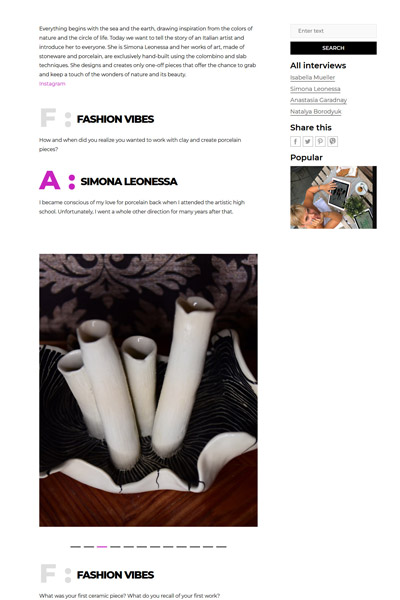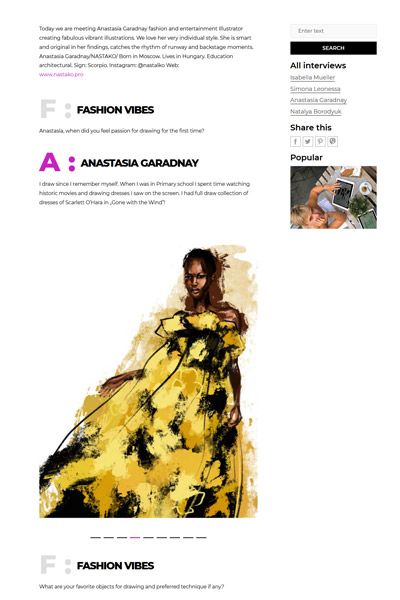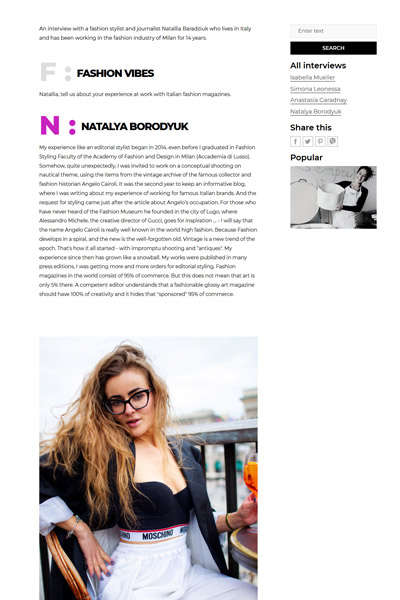An interview with a fashion stylist and journalist Natallia Baradziuk who lives in Italy and has been working in the fashion industry of Milan for 14 years.
My experience like an editorial stylist began in 2014, even before I graduated in Fashion Styling Faculty of the Academy of Fashion and Design in Milan (Accademia di Lusso). Somehow, quite unexpectedly, I was invited to work on a conceptual shooting on nautical theme, using the items from the vintage archive of the famous collector and fashion historian Angelo Cairoli. It was the second year to keep an informative blog, where I was writing about my experience of working for famous Italian brands. And the request for styling came just after the article about Angelo’s occupation. For those who have never heard of the Fashion Museum he founded in the city of Lugo, where Alessandro Michele, the creative director of Gucci, goes for inspiration ... - I will say that the name Angelo Cairoli is really well known in the world high fashion. Because Fashion develops in a spiral, and the new is the well-forgotten old. Vintage is a new trend of the epoch. That's how it all started - with impromptu shooting and "antiques". My experience since then has grown like a snowball. My works were published in many press editions, I was getting more and more orders for editorial styling. Fashion magazines in the world consist of 95% of commerce. But this does not mean that art is only 5% there. A competent editor understands that a fashionable glossy art magazine should have 100% of creativity and it hides that "sponsored" 95% of commerce.
First of all, a good journalist should be very competent and be able to logically structure texts, as well as to filter different material. Because in the modern world we are all literally "inundated" with information. Everybody writes now about everything - and nobody keeps to excellent results in grammar and literature. A good journalist, in addition to outstanding communicative skills, must have a broad outlook and solid knowledge of world culture, starting from ancient times.
An ideal client is a motivated client, but in general we educate our clients ourselves. Few of us know what exactly we want, so often you have to communicate with people for a long time before offering them something really useful, not momentary.
Trends are the ideas, thoughts and symbols that “float in the air” and influence emerging fashion tips. Therefore, I treat them very carefully, because they reflect the global situation and our subconscious attitude to certain events. All of this is reflected in fashion and has a great communicative value.
Of course, but I am not her slave. Rather, on the contrary - I adapt all new trends to me and my character. After all, we live in the era of individualism and universality. At the peak - the one who has his own opinion and his own personal style.
The difference in proportion is exactly the same as between trends and fashion tips - in the globality of expression. A talented observer will perfectly tell you what colors are in fashion now and what are the new ideas and features of the cut, and the genius one will come deeper and tells you where these trends came from and what trend gave rise to them.
The world of fashion is evolving exactly as our consciousness and global thinking evolve. Fashion is essentially a system of symbols and one of the world's most powerful means of mass influence.
Communication is an actual power of future fashion. After all, each our outfit or accessory symbolizes and tells us something.
I don't quite understand what it means to be not stylish. If it's about pajamas in the morning or a tracksuit when you run to the supermarket, then yes - this is inevitable. But this is also a kind of style.
My wardrobe is divided into two parts: basic items and "curiosities" - that is, exclusive items from the limited collections of my favorite brands. I would call myself a collector rather than a shopping addicted. I rarely make spontaneous purchases. Mostly I buy “masterpieces”.
I would advise to all designers to be more creative, attentive structuring their collections, and not to focus only on sewing and "cloning" "purchased" things (I deliberately wrote the word "purchased" in quotes); and also to be more environmentally friendly.
Happiness is when I enjoy the moment here and now.
Getting rid of Covid is first of all! And if we think in general, we would like people to become less superficial and more tolerant to each other - especially in such difficult situations as now.










